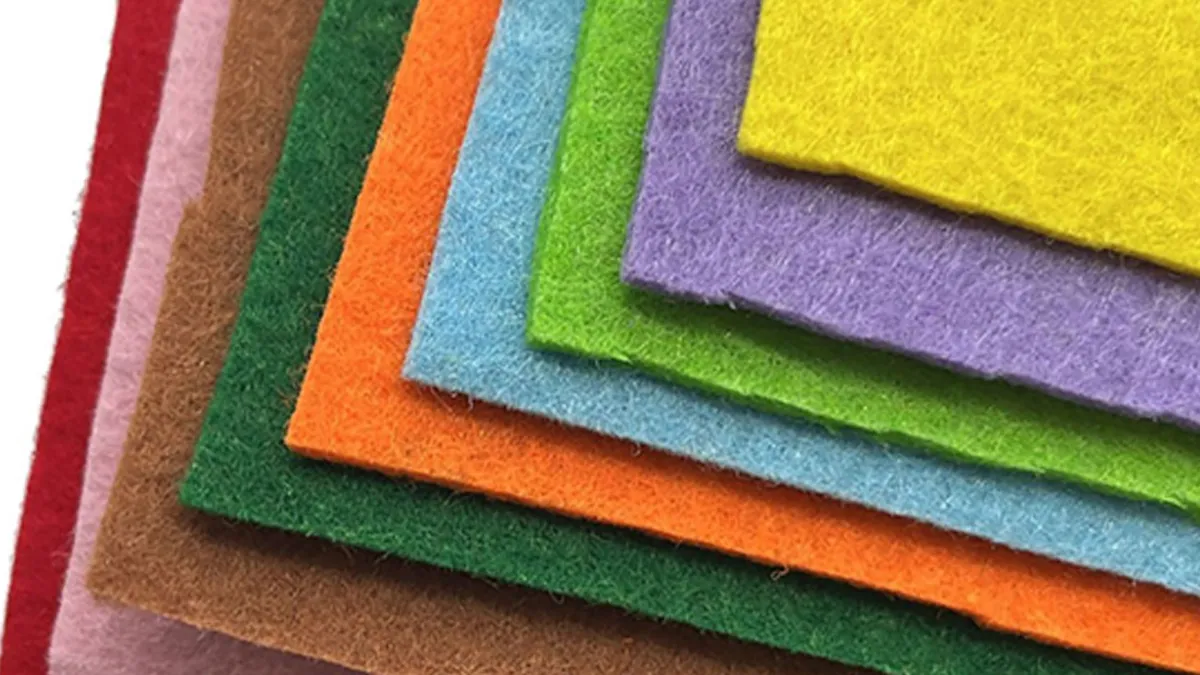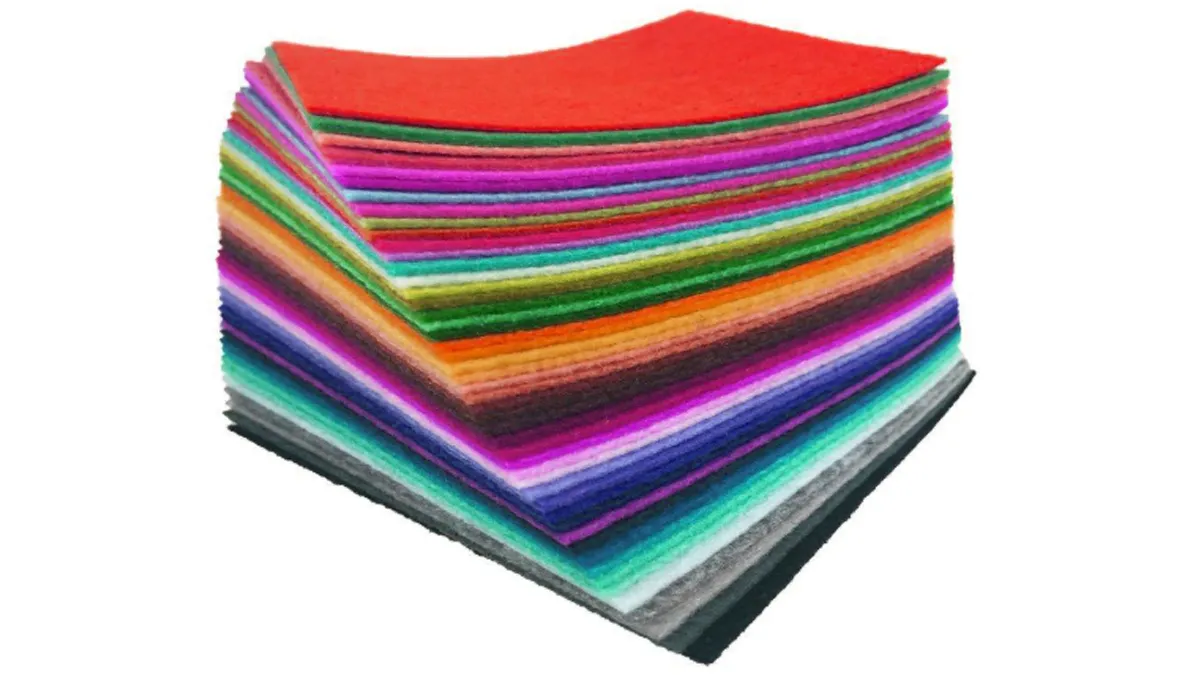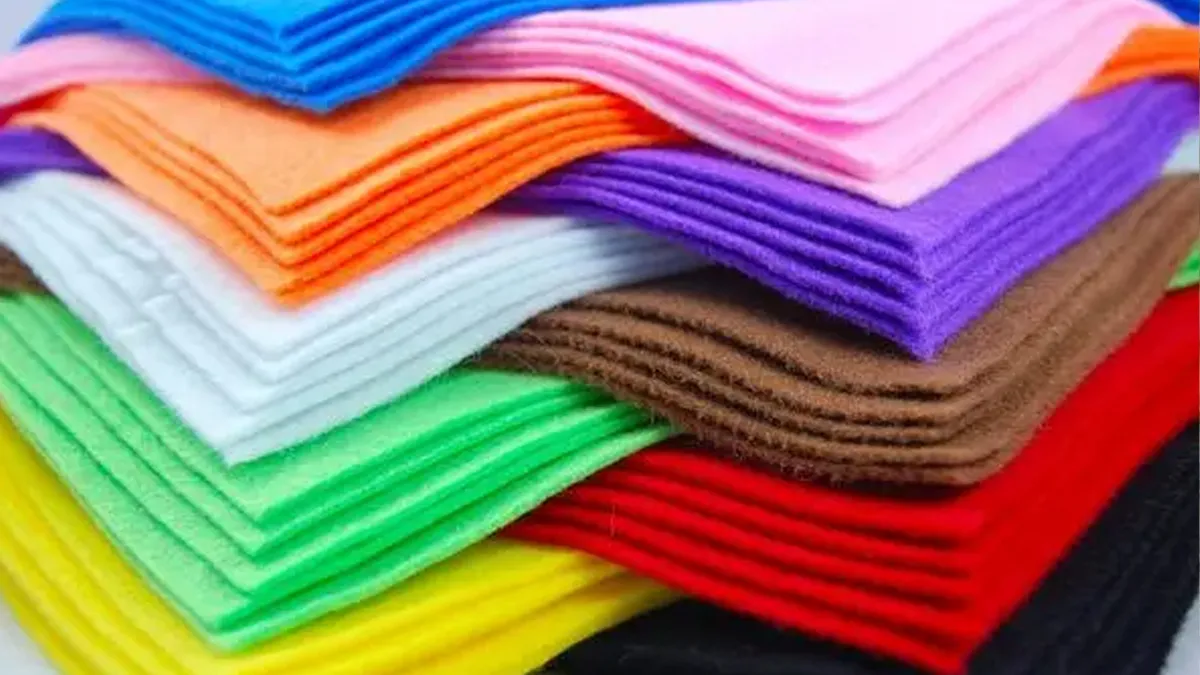Felt fabric is a material made by compressing fibers together. Unlike woven or knitted fabrics, it forms through pressure and friction. Makers use wool, polyester, or blends to create different types of felt.

This fabric is strong, versatile, and easy to shape. You see it in crafts, fashion, and more importantly, in bags. From shopping totes to stylish organizers, felt fabric gives bags a mix of durability and a clean, modern look.
What Is Felt Fabric Made Of?
Felt fabric does not come from weaving or knitting. Instead, it is produced by matting and compressing fibers together. These fibers can come from different sources, and the choice of material affects the look, feel, and durability of the final fabric.

Natural fibers: Wool is the most traditional option, famous for its softness and warmth. Other animal fibers like alpaca or camel hair can also be used to make premium felt. Natural felt is biodegradable and breathable, which makes it attractive for eco friendly bags.
Synthetic fibers: Polyester and acrylic are popular choices for industrial felt. They make the fabric more resistant to moisture and wear, and they are much cheaper to produce. Synthetic felt is widely used for promotional bags and large scale OEM production.
Blended fibers: Some felt fabrics combine natural and synthetic fibers to balance softness, strength, and cost. For example, a blend of wool and polyester makes a bag look upscale while keeping it durable enough for daily use.
When we talk about what felt fabric is made of, the answer can be very different depending on whether you are buying a luxury felt tote or a promotional felt shopping bag.
How Is Felt Fabric Made?
Felt fabric is special because it is not woven or knitted. Instead, fibers are tangled and compressed until they lock together. There are three main methods to make felt:
- Wet felting: This is the most traditional technique and one of the oldest textile methods in the world. Warm water, soap, and continuous friction cause wool fibers to swell, twist, and lock tightly together. The result is a dense, soft material that has a natural, rustic feel. Wet felting is still used today for handmade items, especially small craft bags, pouches, or artistic designs. Because each piece is made by hand, these bags often carry a unique character and are popular in artisan markets.
- Needle felting: Unlike wet felting, this method does not use water. Instead, it relies on barbed needles that repeatedly punch into the fibers, forcing them to tangle and bond. Needle felting is extremely popular in the DIY community because it allows precise control over shapes and patterns. In bag making, needle felt is often used for decorative panels, custom embellishments, or limited edition designs where detail and texture matter more than mass production.
- Industrial felting: For large scale production, factories use heavy machines that compress fibers with heat and pressure. This process creates rolls of uniform felt fabric that can be cut and shaped into consistent patterns. Industrial felt is ideal for bag manufacturing because it ensures strength, consistency, and cost efficiency. Many polyester felt shopping totes, promotional bags, and storage organizers come from this process, making it the backbone of OEM and wholesale production.
What makes felt special is that no matter how it is made, it keeps the same core qualities—strength, flexibility, and easy customization. That is why it continues to be a favorite material for both traditional artisans and modern bag manufacturers.
Types of Felt Fabric

There are many different types of felt, and each has its own use in the bag industry.
- Wool felt: This is the classic choice. It feels soft, warm, and natural, which makes it popular in fashion bags, luxury totes, and high end storage bags. Brands often use wool felt when they want a premium look and eco friendly appeal.
- Polyester felt: This version is more budget friendly but still strong. Because it is affordable and durable, you see it a lot in promotional totes, shopping bags, and other bulk orders. It is practical, lightweight, and easy to print on.
- Blended felt: By mixing wool and polyester, you get a balance of style and durability. These blends work well for mid range bags where you need a mix of comfort, toughness, and cost efficiency.
- Needle felt: This type is popular in the craft world. Artisans and DIY makers use it for small bags, unique pouches, or limited edition designs that focus on creativity and detail.
| Type of Felt | Key Features | Best Uses in Bags |
|---|---|---|
| Wool Felt | Soft, natural, eco friendly | Fashion totes, premium handbags, storage bags |
| Polyester Felt | Affordable, durable, easy to print | Promotional totes, shopping bags, bulk orders |
| Blended Felt | Mix of style and toughness | Mid range bags, daily use totes, organizers |
| Needle Felt | Craft friendly, textured surface | DIY projects, artisan pouches, custom designs |
Properties of Felt Fabric in Bags
Felt fabric has some unique qualities that make it ideal for bags.
- Durability: Felt can handle daily wear and tear, making it reliable for shopping or storage bags.
- Shape retention: Because of its density, felt holds its shape well. That is why felt totes often look structured even without inner lining.
- Eco friendly options: Wool felt is biodegradable, and even polyester felt can be recycled. This makes it appealing for sustainable brands.
- Easy customization: Felt is easy to cut, sew, and print on, which makes it perfect for custom bags with logos or designs.
- Insulation: Felt has natural insulating qualities, which is why felt lunch bags or cooler bags are growing in popularity.
Advantages of Felt Fabric
Why do so many manufacturers and brands choose felt for their bags. The answer lies in the benefits.
- No fraying: Unlike woven fabrics, felt does not unravel. This makes cutting and shaping much easier.
- Lightweight but strong: Felt bags are comfortable to carry yet strong enough for daily essentials.
- Variety: Available in many colors, thicknesses, and densities.
- Eco appeal: Wool felt bags send a strong eco friendly message, which is important for branding.
- Custom friendly: From silk screen printing to embroidery, felt takes customization very well.
Disadvantages of Felt Fabric
Of course, no fabric is perfect. Felt also has some drawbacks to consider.
- Moisture sensitivity: Natural wool felt can shrink or deform if it gets too wet.
- Not for heavy loads: Felt bags are great for daily use but not ideal for carrying very heavy groceries or books.
- Price differences: Wool felt can be much more expensive than synthetic options, which limits its use for budget projects.
Applications of Felt Fabric
Felt is everywhere, but its use in bags deserves special attention.
| Category | Description | Common Examples |
|---|---|---|
| Fashion and Lifestyle | Felt totes and handbags combine a clean, minimal look with practical strength. Designers value its structure, and consumers love the soft yet sturdy feel. | Fashion totes, handbags, everyday carry bags |
| Promotional and Business | Polyester felt is affordable, lightweight, and easy to customize with printing or embroidery, making it perfect for giveaways or branding. | Promotional totes, corporate gift bags |
| Storage and Home | Felt baskets and organizers add a modern touch to home spaces while being strong enough to hold clothes, toys, or magazines. | Storage bins, laundry bags, closet organizers |
| Travel and Accessories | Felt gives light protection without adding bulk, which makes it ideal for travel organizers and tech sleeves. | Laptop sleeves, pouches, passport holders |
How to Care for Felt Fabric and Bags?
Caring for felt bags is not difficult, but it does require some attention.
- Cleaning: Hand washing with cold water is recommended. Avoid hot water or machine washing for wool felt, as it may shrink. Polyester felt is more forgiving.
- Drying: Lay the bag flat to dry, and reshape it while damp to maintain its structure.
- Storage: Keep in a dry, cool place to avoid mold or deformation.
- Extra protection: Spraying a water resistant coating can extend the life of felt bags.
Comparison Table: Wool Felt vs Polyester Felt in Bags
| Feature | Wool Felt Bags | Polyester Felt Bags |
|---|---|---|
| Material | Natural animal fibers | Synthetic fibers |
| Durability | Good, but sensitive to moisture | Very durable and water resistant |
| Eco Friendly | Biodegradable and sustainable | Recyclable but less eco friendly |
| Price | Higher, premium positioning | Affordable, bulk friendly |
| Best Uses | Fashion, gifts, lifestyle bags | Promotions, shopping, storage bags |
Conclusion
So, what is felt fabric. In simple words, it is a non woven textile made from natural or synthetic fibers that are compressed into a dense, durable fabric. Depending on whether it is wool or polyester, felt can be eco friendly, affordable, or a mix of both.
For bags, felt has become a favorite because it is versatile, easy to customize, and appealing to eco conscious consumers. Whether you want high end wool felt handbags or bulk polyester felt shopping totes, the options are wide.
As a professional bag manufacturer, we produce a full range of felt bags, shopping totes, storage organizers, and fashion accessories. We support OEM, ODM, and wholesale services, helping brands and businesses create bags that match their needs. If you are looking for custom felt bags with your logo or design, contact us today for samples and a quick quote.
FAQ
Are felt bags durable for everyday use?
Felt bags are great for daily errands, light shopping, or carrying personal items. They are not designed to carry very heavy loads, but for regular use like carrying clothes, lunch, or books, they perform very well. Wool felt has a softer feel, while polyester felt is tougher and more resistant to moisture.
Are felt bags eco friendly?
Yes, especially if they are made from wool or other natural fibers. Wool felt is biodegradable and sustainable, while polyester felt is recyclable. Many brands choose felt bags to highlight their eco conscious image.
Can felt bags be washed?
It depends on the type. Wool felt should be hand washed gently and dried flat, while polyester felt can handle mild machine washing. Always avoid hot water or dryers, since heat can shrink or warp the fabric.
What is the difference between wool felt and polyester felt for bags?
Wool felt looks and feels more luxurious, but it is more expensive and sensitive to moisture. Polyester felt is cheaper, tougher, and better suited for bulk production. Both have their place, depending on whether you want a premium product or a practical promotional bag.
Why do brands choose felt bags for promotions?
Felt bags are affordable, easy to print on, and look stylish. They make a great balance between cost and branding impact. Companies use them as giveaway items, conference bags, or custom shopping totes because they are lightweight yet strong enough to be used multiple times.




